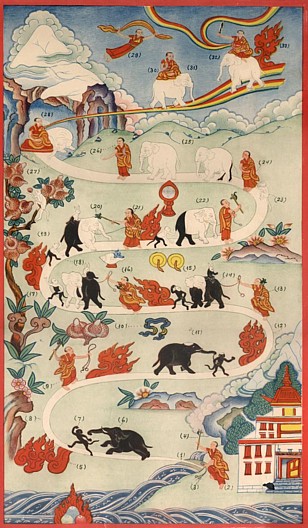Nine ways of resting the mind
Jump to navigation
Jump to search

Nine ways of resting the mind (Tib. སེམས་གནས་པའི་ཐབས་དགུ་, sem nepé tab gu; Wyl. sems gnas pa’i thabs dgu) — whatever the object of our meditation, we pass through nine stages in the development of shamatha.
- Resting the Mind (Tib. འཇོག་པ་, jokpa) – focusing the mind upon an object [number 2 on the illustration]
- Resting the Mind Longer (Tib. རྒྱུན་དུ་འཇོག་པ་, gyündu jokpa) – maintaining that continuity [9]
- Continuously Resettling the Mind (Tib. བླན་ཏེ་འཇོག་པ་, len té jokpa) – whenever one forgets the object and becomes distracted one resettles the mind [13]
- Fully Settling the Mind (Tib. ཉེ་བར་འཇོག་པ་, nyewar jokpa) – by settling in that way, the mind becomes increasingly focused on the object [16]
- Taming the Mind (Tib. དུལ་བར་བྱེད་པ་, dulwar jepa) – by thinking of the qualities of samadhi, one feels greater joy for meditation [21]
- Pacification of the Mind (Tib. ཞི་བར་བྱེད་པ་, shyiwar jepa) – then seeing the faults of distraction, one’s dislike for meditation is pacified [22]
- Complete Pacification of the Mind (Tib. རྣམ་པར་ཞི་བར་བྱེད་པ་, nampar shyiwar jepa) – then whenever the cause of distraction, such as the subsidiary disturbing emotions or sleepiness or mental unease occur, they are completely pacified [24]
- One-pointedness (Tib. རྩེ་གཅིག་ཏུ་བྱེད་པ་, tsechik tu jepa) – then one attains some stability through applying the antidotes for distraction [26]
- Resting in Equanimity (Tib. མཉམ་པར་འཇོག་པ་བྱེད་པ་, nyampar jokpa jepa) – finally one is able to rest the mind on its object quite naturally, without resorting to any antidotes [28]
The ninth stage of resting the mind is also known as the ‘one-pointed mind of the desire realm’ (Tib. འདོད་སེམས་རྩེ་གཅིག་པ་, Wyl. ‘dod sems rtse gcig pa).
These are taken from Maitreya's Ornament of Mahayana Sutras (Skt. Mahayanasutralankara).
Six Powers
| This section contains Tibetan script. Without proper Tibetan rendering support configured, you may see other symbols instead of Tibetan script. |
These stages are accomplished through the six powers (Skt. ṣaḍbala; Tib. སྟོབས་དྲུག་, tob druk; Wyl. stobs drug):
- Listening/study (Skt. śrūtabala; Tib. ཐོས་པ་, töpa; Wyl. thos pa) – ‘resting the mind’ is accomplished through listening to meditation instructions
- Reflection (Skt. āśayabala; Tib. བསམ་པ་, sampa; Wyl. bsam pa) – ‘resting the mind longer’ is accomplished through reflection and contemplation
- Mindfulness (Skt. smṛtibala; Tib. དྲན་པ་, drenpa; Wyl. dran pa) – through mindfulness one accomplishes ‘continuously resettling’ and ‘fully settling the mind’; whenever one is distracted one gathers the mind and slowly, through habituation, non-distraction occurs
- Awareness (Skt. saṃprajanyabala; Tib. ཤེས་བཞིན་, shé shyin; Wyl. shes bzhin) – through awareness one accomplishes ‘taming the mind’, ‘pacifying the mind’ and ‘completely pacifying the mind’; with joy for awareness and seeing the faults of succumbing to thoughts and negative emotions, one no longer falls prey to them
- Diligence (Skt. vīryabala; Tib. བརྩོན་འགྲུས་, tsöndrü; Wyl. brtson ‘grus) – through diligence one accomplishes ‘complete pacification’ and ‘one-pointedness’; even subtle thoughts and negative emotions are abandoned
- Complete familiarity (Skt. abhyasabala; Tib. ཡོངས་སུ་འདྲིས་པ་, yongsu dripa; Wyl. yongs su ‘dris pa) – the final stage of ‘resting in equanimity’ where the mind is unaffected by the obstacles of dullness or agitation is accomplished through complete familiarity.
Four Mental Engagements
All of these stages can be condensed into the four mental engagements (Tib. ཡིད་ལ་བྱེད་པ་བཞི་, yi la jepa shyi, Wyl. yid la byed pa bzhi):
- tightly focused engagement (Tib. བསྒྲིམས་ཏེ་འཇུག་པའི་ཡིད་བྱེད་, drim té jukpé yi jé) – relates to the first two stages of resting the mind
- interrupted engagement (Tib. ཆད་ཅིང་འཇུག་པའི་ཡིད་བྱེད་, ché ching jukpé yi jé) – this occurs from stage three to stage seven, when one is still susceptible to the obstacles of dullness and agitation and is therefore unable to abide for a long time
- uninterrupted engagement (Tib. ཆད་པར་མེད་པར་འཇུག་པའི་ཡིད་བྱེད་, chepar mepar jukpé yi jé – at stage eight one is able to remain unaffected by the obstacles of dullness and agitation without too much exertion
- effortless engagement (Tib. རྩོལ་བ་མེད་པར་འཇུག་པའི་ཡིད་བྱེད་, tsolwa mepar jukpé yi jé) – at the ninth stage one is able to maintain the practice effortlessly
Alternative Translations
- Nine stages of resting the mind
Notes
- ↑ On a large scale, this picture depicts the complete process or path of shamatha. On a smaller scale, it illustrates the process we go through in almost every meditation session.
Internal Links
Further Reading
- Dzogchen Ponlop, Wild Awakening (Boston & London: Shambhala, 2003), pages 100-109.
- Khenchen Thrangu Rinpoche, The Practice of Tranquility and Insight—A Guide to Tibetan Buddhist Meditation (Ithaca: Snow Lion Publications, 1993), pages 46-55.
- Sogyal Rinpoche, A Treasury of Dharma (Lodeve: Rigpa, 2005), pages 206-225.
